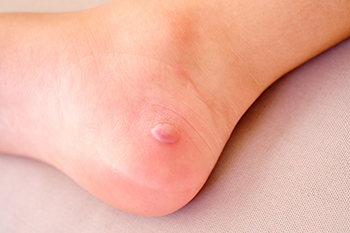
Blisters on the feet often form from friction, usually when skin rubs against tight or poorly fitted shoes. This repeated pressure separates layers of skin, allowing fluid to collect. Blisters can also appear due to burns, cold exposure, allergic reactions, or infections. On the feet, these fluid-filled pockets can become painful, especially when walking. Popping a blister yourself is not recommended, as breaking the skin increases the risk of infection. People with diabetes or circulation issues should be especially cautious, as blisters can become infected more easily. Signs of infection include redness, swelling, warmth, or pus. A podiatrist can evaluate the blister, relieve pressure safely, and recommend treatment to reduce pain and protect the surrounding skin. If you have developed a problematic blister on your foot, it is suggested that you schedule an appointment with a podiatrist for an exam and treatment options.
Blisters are prone to making everyday activities extremely uncomfortable. If your feet are hurting, contact one of our podiatrists of Pocono Foot & Ankle Consultants. our doctors can provide the care you need to keep you pain-free and on your feet.
Foot Blisters
Foot blisters develop as a result of constantly wearing tight or ill-fitting footwear. This happens due to the constant rubbing from the shoe, which can often lead to pain.
What Are Foot Blisters?
A foot blister is a small fluid-filled pocket that forms on the upper-most layer of the skin. Blisters are filled with clear fluid and can lead to blood drainage or pus if the area becomes infected.
How Do Blisters Form?
Blisters on the feet are often the result of constant friction of skin and material, usually by shoe rubbing. Walking in sandals, boots, or shoes that don’t fit properly for long periods of time can result in a blister. Having consistent foot moisture and humidity can easily lead to blister formation.
Prevention & Treatment
It is important to properly care for the affected area in order to prevent infection and ease the pain. Do not lance the blister and use a Band-Aid to provide pain relief. Also, be sure to keep your feet dry and wear proper fitting shoes. If you see blood or pus in a blister, seek assistance from a podiatrist.
If you have any questions, please feel free to contact our offices located in Stroudsburg, Nazareth, and Easton, PA . We offer the newest diagnostic and treatment technologies for all your foot care needs.
